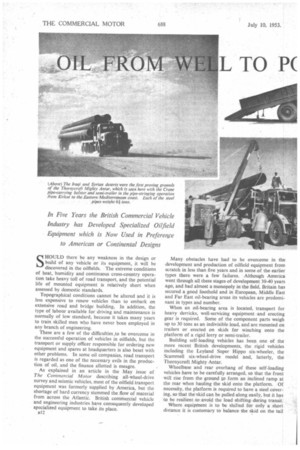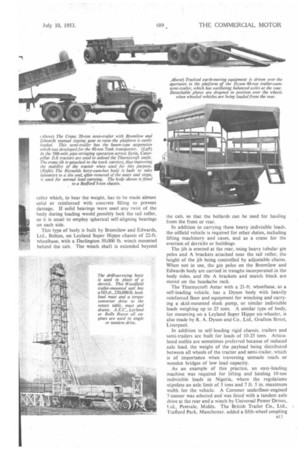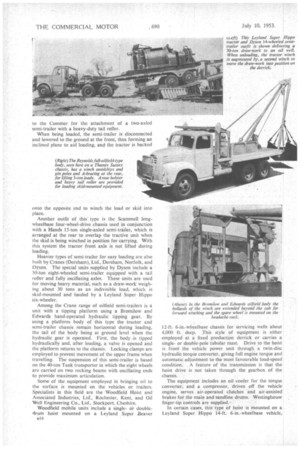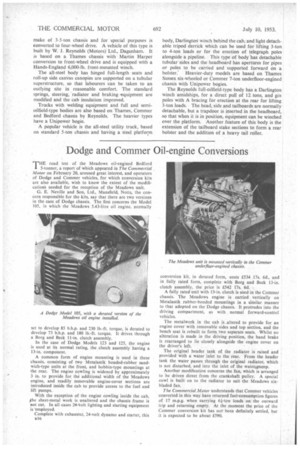L TO P(
Page 38

Page 39

Page 40

Page 41

Page 42

If you've noticed an error in this article please click here to report it so we can fix it.
In Five Years the British Commercial Vehicle Industry has Developed Specialized Oilfield Equipment which is Now Used in Preference to American or Continental Designs
SHOULD there be any weakness in the design or build of any vehicle or its equipment, it will be discovered in the oilfields. The extreme conditions of heat, humidity and continuous cross-country operation take heavy toll of road transport, and the potential life of mounted equipment is relatively short when assessed by domestic standards.
Topographical conditions cannot be altered and it is less expensive to renew vehicles than to embark on extensive road and bridge building, In addition, the type of labour available for driving and maintenance is normally of low standard, because it takes many years to train skilled men who have never been employed in any branch of engineering.
These are a few of the difficulties,to be overcome in the successful operation of vehicles in oilfields, but the transport or supply officer responsible for ordering new equipment and spares at headquarters is also beset with other problems. In some oil companies, road transport is regarded as one of the necessary evils in the production of oil, and the finance allotted is meagre.
As explained in an article in the May issue of The Commercial Motor describing all-wheel-drive survey and seismic vehicles, most of the oilfield transport equipment was formerly supplied by America, but the shortage of hard currency stemmed the flow of material from across the Atlantic. British commercial vehicle and engineering industries have consequently developed specialized equipment to take its place. 012 Many obstacles have had to be overcome in the development and production of oilfield equipment from scratch in less than five years and in some of the earlier types there were a few failures. Although America went through all these stages of development 30-40 years ago, and had almost a monopoly in the field, Britain has secured a good foothold and in European, Middle East and Far East oil-bearing areas its vehicles are predominant in types and number.
When an oil-bearing area is located, transport for heavy derricks, well-servicing equipment -and erecting gear is required. Some of the component parts weigh up to 30 tons as an indivisible load, and are mounted on trailers or erected on skids for winching onto the platform of a rigid lorry or semi-trailer.
Building self-loading vehicles has been one of the more recent British developments, the rigid vehicles including the Leyland Super Hippo six-wheeler, the Scammell six-wheel-drive model and, latterly, the Thornycroft Mighty Antar.
Wheelbase and rear overhang of these self-loading vehicles have to be carefully arranged, so that the front will rise from the ground to form an inclined ramp at The rear when hauling the skid onto the platform. Of necessity, the platform is required to have a steel covering, so that the skid can be pulled along easily, but it has to be resilient to avoid the load shifting during transit.
Where equipment is to be shifted for only a short distance it is customary to balance the skid on the tail roller which, to bear the weight, has to be made almost solid or reinforced with concrete filling to prevent damage. If solid bearings were used any twist of the body during loading would possibly lock the tail roller, so it is usual to employ spherical self-aligning bearings on each side.
This type of body is built by Bromilow and Edwards, Ltd., Bolton, on Leyland Super Hippo chassis of 22-ft. wheelbase, with a Darlington 50,000 lb. winch mounted behind the cab. The winch shaft is extended beyond the cab, so that the bollards can be used for hauling from the front or rear.
In addition to carrying these heavy indivisible loads. the oilfield vehicle is required for other duties, including lifting machinery and cases, and as a crane for the erection of derricks or buildings.
The jib is erected at the rear, using heavy tubular gin poles and A brackets attached near the tail roller, the height of the jib being controlled by adjustable chains. When not in use, the gin poles on the Brornilow and Edwards body are carried in troughs incorporated in the body sides, and file A brackets and snatch block are stored on the headache rack.
The Thornycroft Antar with a 21-ft. wheelbase, as a self-loading vehicle, has a Dyson body with heavily reinforced floor and equipment for winching and carrying a skid-mounted slush pump, or similar indivisible loads weighing up to 25 tons. A similar type of body, for mounting on a Leyland Super Hippo six-wheeler, is also made by R. A. Dyson and Co„ Ltd., Grafton Street, Liverpool.
In addition to self-loading rigid chassis, trailers and semi-trailers are built for loads of 10-25 tons. Articulated outfits are sometimes preferred because of reduced axle load, the weight of the payload being distributed between all wheels of the tractor and semi-trailer, which is of importance when traversing unmade roads or wooden bridges of low load capacity.
As an example of this practice, an easy-loading machine was required for lifting and hauling 10-ton indivisible loads in Nigeria, where the regulations stipulate an axle limit of 5 tons and 7 ft. 5 in. maximum width for the vehicle. A Commer underfloor-engined 7-tonner was selected and was fitted with a tandem axle drive at the rear and a winch by Universal Power Drives, Ltd., Pekvale, Middx. The British Trailer Co., Ltd., Trafford Park, Manchester, added a fifth-wheel coupling to the Commer for the attachment of a two-axled semi-trailer with a heavy-duty tail roller.
When being loaded, the semi-trailer is disconnected and lowered to the ground at the front, thus forming an inclined plane to aid loading, and the tractor is backed onto the opposite end to winch the load or skid into place.
Another outfit of this type is the Scammell longwheelbase four-wheel-drive chassis used in conjunction with a Hands 15-ton single-axled semi-trailer, which is arranged at the rear to overlap the tractive unit when the skid is being winched in position for carrying. With this system the tractor front axle is not lifted during loading.
Heavier types of semi-trailer for easy loading are also huilt by Cranes (Dereham), Ltd., Dereham, Norfolk, and Dyson. The special units supplied by Dyson include a 30-ton eight-wheeled semi-trailer equipped with a tail roller and fully oscillating axles. These units are used for moving heavy material, such as a draw-work weighing about 30 tons as an indivisible load, which is skid-mounted and hauled by a Leyland Super Hippo six-wheeler.
Among the Crane range of oilfield semi-trailers is a unit with a tipping platform using a Bromilow and Edwards hand-operated hydraulic tipping gear. By using a platform body of this type the tractor and semi-trailer chassis remain horizontal during loading. the tail of the body being at ground level when the hydraulic gear is operated. First, the body is tipped hydraulically and, after loading, a valve is opened and the platform returns to the chassis. Locking clamps are employed to prevent movement of the upper frame when travelling. The suspension of this semi-trailer is based on the 40-ton Tank transporter in which the eight wheels are carried on two rocking beams with oscillating ends to provide maximum articulation.
Some of the equipment employed in bringing oil to the surface is mounted on the vehicles or trailers. Specialists in this field are the • Woodfield Hoist and Associated Industries, Ltd., Rochester, Kent, and Oil Well Engineering Co., Ltd., Stockport, Cheshire, Woodfield mobile units include a singleor doubleelrum hoist mounted on a Leyland Super Beaver 12-ft. 6-in.-wheelbase chassis for servicing wells about 4,000 ft. deep. This style of equipment is either employed at a fixed production derrick or carries a singleor double-pole tubular mast. Drive to the hoist is front the vehicle power unit through a twin-disc hydraulic torque converter, giving full engine torque and automatic adjustment to the most favourable load-speed condition. A feature of the transmission is that the hoist drive is not taken through the gearbox of the chassis.
The equipment includes an oil cooler for the torque converter, and a compressor, driven off the vehicle engine, serves air-operated clutches and air-assisted brakes for the main and sandline drums. Westinghouse finger-tip controls are supplied.
In certain cases, this .type of hoist is mounted, on a Leyland Super Hippo 14-ft. 6-in.-wheelbase vehicle,
giving a favourable performance on bad road surfaces with the load distributed over 10 wheels and tyres.
For wells up to about 7,000-ft. deep, where a fully mobile mast or derrick is required, the Woodfield equipment may be carried on a Leyland Hippo or Scammell. Constructor chassis with mid-bed engine hoist drive or power-take-off drive from the vehicle
engine. Rolls-Royce, A.E.C. or Leyland oil engines are used for the hoist power.
The equipment in this form, with mid-bed engine drive to the hoist, carries masts up to 89 ft. high for a hook load of up to 180,000 lb. Above this capacity the hoist and servicing units are mounted on trailers or semitrailers and a typical rig of Woodfield design has a I03-ft. telescoping mast of 250,000-lb. hook-load capacity, the mast and draw-works being carried on a trailer.
A range of capacities is available embodying hoist power units compounded with hydraulic torqueconverter transmission, but it is essential that all details of the complete equipment should be designed to minimum weight to promote the utmost mobility when working across country.
With oil located from almost surface level to several thousands of feet below ground, and various types of subsoil between, the range of drilling and servicing equipment must necessarily be diverse. Basic units must, therefore, be built and -adapted to the various requirements. In some of the more specialized equipment, which has to be used to service several wells in a small area, it is found preferable to mount it directly on a chassis, reinforcing the frame and using solid-beam suspension for the bogie to accommodate the unusual load, coupled with continuous cross-botmtry operation. Some of these mounted units weigh up to 25 tons and are based on six-wheeled overseas-type chassis.
After initial drilling has disclosed a good oil-bearing area below the earth crust, the next stage is to convey the crude oil to a refinery or tank farm near the coast, in preparation for shipping, and may involve stringing a pipeline. Thornycroft Mighty Antar tractors and Crane pipe-carrying trailer units made history in the transport and stringing of 560 miles of pipe in record time from Kirkut to the port of 13anias on the eastern Mediterranean coast.
The steel pipes, each weighing 61 tons and 30 in. in diameter and .93 ft. long, were carried across desert tracks and sandy wastes in temperatures ranging from 200 of frost to 120° F. in the shade in summer.
Admittedly, this was an unusually large project, but for normal pipe stringing the standard tractive unit, as supplied by any of the British heavy-vehicle manufacturers, is found sufficient to haul pipe-carrying trailers. Although designed specifically for oilfield use, these trailers are of more modest dimensions.
Earth-moving equipment, to ditch and level the ground in preparation for pipe-laying, has to be carried to strategic points and for this purpose the trailer makers have developed special low-loading and walk-over lowbed units. This type has a level platform from behind the front bogie or articulated attachment at the front and is cut away at the rear wheels, and is planned for side or rear loading.
When heavy crawler equipment is being loaded from the rear, the tracks bridge the gaps in the platform over the wheels, but detachable metal plates complete the platform when a wheeled vehicle is being driven on to the trailer. This type of equipment, built by Crane and Dyson, is often used as an easy-loading unit for skid mounted machinery.
Trailers and articulated units are used in the oilfields for many purposes, such as for passenger transport and for field kitchens. After a spell of early-morning duty as the prime mover of an articulated bus, the tractor is operated during the day with other semi-trailers of various types to move sundry equipment or spares, and it returns to its role of passenger carrier at the end of the shift. As a field kitchen it leaves a central depot and serves to house and feed workmen engaged in pipe-laying or repair at an outlying site. Another vehicle which has many uses is the lorry cum-native-labour bus, which is based on any standard make of 3-5-ton chassis and for special purposes is converted to four-wheel drive. A vehicle of this type is built by W. J. Reynolds (Motors) Ltd., Dagenham. It is 'based on a Thames chassis with Martin Harper conversion to front-wheel drive and is equipped with a Hands-England 6,000-lb. front-mounted winch.
The all-steel body has hinged full-length seats and roll-up side canvas canopies are supported on a tubular superstructure, so that labourers can be taken to an outlying site in reasonable comfort. The standard springs, steering, radiator and braking .equipment are modified and the cab insulation improved.
Trucks with welding equipment and full and semioilfield-type bodies are also based on Thames, Commer and Bedford chassis by Reynolds. The heavier types have a Unipower bogie.
A popular vehicle is the all-steel utility truck, based on standard 5-ton chassis and having a steel platform body, Darlington winch behind the cab, and light detachable tripod derrick which can be used for lifting 3-ton to 4-ton loads or for the erection of telegraph poles alongside a pipeline. This type of body has detachable tubular sides and the headboard has apertures for pipes or poles to be carried and supported forward on a bolster: Heavier-duty models are based on Thames Sussex six-wheeled or Commer 7-ton underfloor-engined chassis with Unipower bogies.
The Reynolds full-oilfield-type body has a Darlington winch amidships, for a direct pull of 12 tons, and gin poles with A bracing for erection at the rear for lifting 3-ton loads. The head, side and tailboards are normally detachable, but a trapdoor is inserted in the headboard, so that when it is in position, equipment can be winched over the platform. Another feature of this body is the extension of the tailboard stake sections to form a rear bolster and the addition of a heavy tail roller.












































































